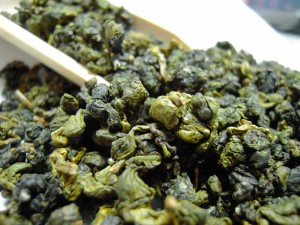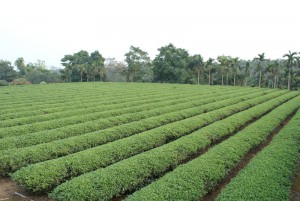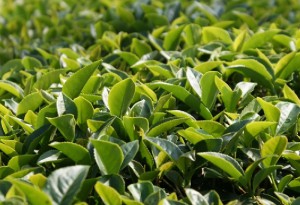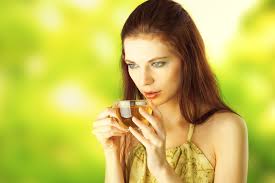I’ve noticed that there is quite a bit of controversy over this tea. Mostly about whether the milk taste and aroma is natural or whether it is enhanced by artificial flavoring. The answer is – both options are available and the best Milk Oolong tea can be either. My company sells a lot of both the unflavored as well as the flavored Milk Oolong tea – and they are both great teas!
Both natural and flavored Milk Oolong are available.
I find people can be quite extreme and fanatic sometimes in the tea world and can tend to look down on what they label as “inferior” teas. Of course there are a lot of inferior teas and fake teas out there as well as people and companies trying to sell a low quality product for a high price – things like this happen in every industry. But it is not always the case and with Milk Oolong for example there are some good quality flavor-enhanced Milk Oolongs made by very quality conscious tea makers. To enjoy drinking a good quality, flavored milk Oolong is just like enjoying a good jasmine green tea – It is almost expected that it will contain jasmine to enhance the flavor. Many Milk Oolong teas being marketed today are flavor enhanced. 100% natural (unflavored) Milk Oolong tea (Jin Xuan Oolong) has a very subtle milk aroma and taste that is barely noticeable for a lot of tea drinkers which is why the added flavor is a popular choice
Where does Milk Oolong tea come from?
Milk Oolong originated in Taiwan from a relatively new strain (or varietal) of tea called Jin Xuan (also named TRES #12 by the Taiwan Tea Research station) in 1980. Jin Xuan tea is now grown quite extensively throughout Taiwan and well as some other countries such as Northern Thailand and Vietnam. The literal translation of this tea varietal is “Golden Lily” and it’s proved to be a very successful discovery by the Taiwan research team as it has a high yield and can be grown in high altitudes. For some reason this tea in its natural form has a subtle nutty, milk aroma and taste when brewed, which is why it was named Nai Xiang (Milk Oolong) by the Taiwan researchers. Certain regions in Taiwan, especially higher elevation area (over 1000m) tend to produce Jin Xuan Oolong with a slightly more milkier aroma and taste profile than other regions. These teas are usually scarcer and therefore more expensive. Most Jin Xuan Oolong tea however, is grown in lower and mid-level elevation regions of central Taiwan. It can be processed and sold as it is, or in some cases the tea farmers decide to add a milk flavoring to it, according to the market demand. The tea itself is usually 100% natural and if there is flavoring added it is usually a harmless milk flavoring or essence that is blended into the loose tea either during the rolling process of the Oolong tea or after the process is completed. Some tea makers, especially in China produce some Milk Oolong using other tea varietals, but these do not have the natural milky notes or aroma as the Jin Xuan varietal and usually need to be flavor enhanced
How can you tell the difference?
If you are insisting on an unflavored Milk Oolong, then it may be better to search for Jinxuan Oolong, although you still might end up with a flavored Milk Oolong. I notice some tea sellers sell both kinds and clarify which one is flavored and which is not, but in most cases if you buy a Milk Oolong and the flavor is pretty pronounced and noticeable, then it is most likely a flavored Milk Oolong, which, as I mentioned earlier is not necessarily a bad thing. There are some very good quality flavored Milk Oolongs out there and if you enjoy the taste, go for it!
What are the health benefits?
Milk Oolong tea benefits are much the same as regular Oolong tea benefits. The Oolong tea itself is made from 100% natural tea leaves with or without flavor enhancement. The tea is picked from a natural tea plant and naturally processed – nothing artificial about the Oolong making process. Only differentials would be if the tea plant is organically grown or not, or pesticides used or not. The Oolong tea making process itself is quite natural basically involving withering, drying and rolling of the leaves. Milk Oolong has all the health benefits attributed to Oolong tea and most other teas as well.
So what is the best Milk Oolong tea?
Well it depends what you are looking for. If the “best” for you means 100% organic, no additives and no prominent milk taste, then I would suggest and more expensive Organic Jin Xuan Milk Oolong. If the “best” means a good quality, milky tasting, moderately priced Milk Oolong, I would suggest a flavor enhanced Milk Oolong from a reputable supplier.
What is your preference and experience with Milk Oolong tea? Feel free to leave a comment below.
You are welcome to try our Milk Oolong which we now have available on Zi Chun Tea Online Shop or our Amazon Tea store.








I am a huge tea drinker. I love trying different tea but my favorites are earl gray and oolong tea. I’ve never had milk oolong tea. What have I been missing?! I will certainly have to check it out. I never thought of oolong tea being milk flavored. You really got my curiosity going.
Yes, Wendy, there is a world of variety out there with teas – both natural and flavored/blended teas. We’ll have some Milk Oolong available to order from our Amazon Tea Store next week.
Hi there Peter,
What a great introduction to Oolong Tea. It is one of my favorite tea, but I seriously have no idea about its origin. I merely like it for its taste. Having said that, I prefer the unflavored version especially if served chilled.
I live in the tropics and non-sweetening tea of any kind is great for quenching thirst on a hot day.
Thanks for your comments Cathy. Glad to hear you enjoy Oolong teas. The great thing about Oolong teas and tea in general is there is so much variety – both with natural unflavored teas as well as almost endless flavors and blends available. here is a brief article I recently wrote listing a few natural Oolong tea varieties, but there are literally 100s of different teas out there!
Unique tea. Outstanding, funny, mysterious, appetizing, evokes various associations. I really like to give this tea guests. I tell them to close your eyes, inhale the scent and tell what they resembles the smell. Initially I thought that the job is very easy. Well, after milky smell … I forgot is that I know the name yet, and it immediately gives me the relevant association. Replies visitors fall really different: coconut, vanilla, cooked cauliflower, raspberries … No one guessed, and play nice. How many people, so many associations. Milk Oolong is among my favorites. We would recommend to anyone who likes to experiment with flavors and aromas.
Thanks for the comment Rafal. Sounds like a fun activity with Milk Oolong and some interesting responses to guessing the taste
Here’s the link to Milk Oolong on our Amazon Store
Hi there Peter,
I have actually heard of Oolong tea as it is very common and easy to find in Thailand. I have no idea that it is actually grown here in the north, I expect that it is the Jinxuan Oolong variety due to the milky taste and the altitude in a lot of areas is indeed above 1000m.
What are the actual health benefits of oolong tea? It would be nice to know as I drink it often.
Hi Derek, Yes, Oolong tea grows well in Northern Thailand. Tea growers in Thailand use several tea strains from Taiwan including Jinxuan and make good quality Oolong teas there and now Thailand origin Oolong tea is exported all over the world.
Here is a recent article I wrote that may be of interest to you on some health benefits of Oolong tea: Is Oolong Tea Good for You
Hey Peter, thank you so much for this article! I’ve often been very curious to try Oolong teas but never understood the difference and then become to shy to order or ask what the differences were (as I didn’t want to come across as a tea numptie!) Have put my order in and can’t wait to try some!
Yes, there are many different varieties of Oolong tea ranging from lightly oxidized almost green tea to a heavily oxidized almost black tea – everything in between is basically a variety of Oolong. Our Milk Oolong is very popular – especially with first time Oolong tea drinkers. It is a pleasant tasting, easy drinking tea.